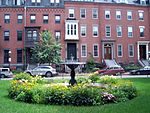Boston Tea Party (concert venue)

The Boston Tea Party was a concert venue located first at 53 Berkeley Street in the South End neighborhood of Boston, Massachusetts, and later relocated to 15 Lansdowne Street in the former site of competitor, the Ark, in Boston's Kenmore Square neighborhood, across the street from Fenway Park. It operated from 1967 to the end of 1970. Its closing was due in part to the increasing cost of hiring bands who were playing more and more at large outdoor festivals and arena rock concerts.The building that the club occupied at 15 Lansdowne Street later reopened multiple times as different clubs before becoming the Avalon in 1992. However, in 2007 Avalon and its neighboring Axis were closed and demolished to make room for a House of Blues, which is what stands on the land today. The venue became associated with the psychedelic movement, being similar in this way to other contemporary rock halls such as New York's Fillmore East and Electric Circus, San Francisco's Fillmore West, and Philadelphia's Electric Factory.
Excerpt from the Wikipedia article Boston Tea Party (concert venue) (License: CC BY-SA 3.0, Authors, Images).Boston Tea Party (concert venue)
Berkeley Street, Boston South End
Geographical coordinates (GPS) Address Website Nearby Places Show on map
Geographical coordinates (GPS)
| Latitude | Longitude |
|---|---|
| N 42.3464216 ° | E -71.0706964 ° |
Address
Revolution Lofts
Berkeley Street
02116 Boston, South End
Massachusetts, United States
Open on Google Maps





